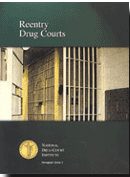[Click on video above, for “Slideshow” of San Francisco Reentry Court Family and Friends’ Barbecue]
THE BEST OF: The following article, initially published on Feb. 1, 2009, describes how Community remains the most effective means of behavioral control, and the most important factor in a successful court-based reentry process.
The powerful National Reentry Movement is substantially local government, community and volunteer driven. Reentry Court judges and other practitioners need to accept the notion that they can be a critical part of reentry reform, without being the controlling force.
The Reentry Court is the Drug Court model writ large. But conventional drug court processes and dynamics often stray from the model, and may not work well for a reentry court. Drug courts, for better or worse, are insular creatures of a judicial system, with judicial concerns; finding funding to support court structure, expanding resources to create effective court programs, and often dictating policy to a small group of community-based organizations (non-profit and otherwise). The historical reason for the court’s insularity are, to a significant extent, based on the courts’ fear of being monitored or controlled by outside organizations and individuals.
Our problem, is that an insular/controlling court can negatively impacts the problem-solving court field, (and the reentry court, in particular) by limiting the court’s ability to work within the community. While the courts should provide needed focus and participant accountability, the Reentry Community derives its extraordinary influence and impact from local government, as well as faith-based, fraternal, and other participating non- profit organizations. The federal government, in its ground breaking “Second Chance Act”, has taken an important step toward recognizing the importance of local community.
Let’s not forget that Problem-solving courts work, in large part because they emmulate (often, without realizing it) the most effective means of behavioral control, the communtiy itself. It is when community began to break down in the U.S. (about 200 years ago) that prisons were created, ultimately usurping the function that historically resided in the community ( See: An Introduction To Community-Based Courts).
Therer is an important final justification for looking to community for support, collaboration, and resources. While reentry funds are pouring into our communities from state and federal sources, in a desperate attempt to staunch overcrowded prisons and failed reentry strategies, there is no guarantee that those funds will continue to flow. Community is the most effective and least expensive resource available to the reentry court. Faith-based, fraternal, and othe volunteer organizations, are the foot soldiers of the reentry movement and stand ready to make a major contribution to your reentry court program; committed to restoring and healing their communites as they have from time immemorial. We, in the criminal justice system, need to engage them as equals and partners. The first question you and your court/community may need to ask, is what is your relationship with the greater community, are you an active member of your community’s “reentry task force”, and how can you strengthen the community of intervenors needed to meet the challenge of the returning ex-offender?
[Note: While the document below, was written in 1993, the issue of community-based funding for community-based courts remains unresolved: see Co-Funding Of Community-Based Courts ].


